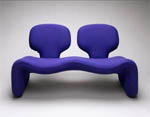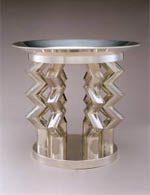Houston Community News >>
8/6/2008 Houston—Offering a glimpse of the
design collections of the Museum of Fine Arts, Houston, this August the
MFAH presents Celebrating 10 Years of the Design Council, an exhibition
of two dozen objects that pays tribute to the friends group funding
design purchases at the MFAH. Founded in 1998, the Design Council is
comprised of community members who share a belief that objects play a
defining role in the way we live in and envision our environment. As
part of their involvement at the MFAH, Design Council members have
access to design experts, learn about collecting, and study objects
first-hand. Once a year they use their funds (derived from membership
dues) to vote on purchases for the museum’s collection. Many of these
objects acquired over the past decade will be on view in the Caroline
Wiess Law Building, 1001 Bissonnet Street, from August 23, 2008 through
January 4, 2009.
“The collection would not be what it is today without the support of the Design Council members,” states Cindi Strauss, MFAH curator of modern and contemporary decorative arts and design and organizer of the exhibition. “The council has been incredibly proactive in seeking out icons of the 20th-century, as well as the latest in contemporary design, singling out tomorrow’s masterpieces today. I’m looking forward to building on the foundation of the past ten years as we move forward in defining the collection.”
“It has been a real privilege for me and the other members of the Design Council to be a part of the process of building a Design collection at the MFAH,” said Marlys Tokerud, chair of the MFAH’s decorative arts subcommittee and long-time Design Council member. “We have assembled works in a wide range of media to ensure that the collection is well-rounded and interesting We are excited to see so many of the objects that we have acquired for the museum on display together, being presented to the public for the first time as a collection.”
On view will be featured works by architects and designers such as Edgar Brandt, Cesare Casati, Donald Deskey, Hella Jongerius, Ingeborg Lundin, Verner Panton, Gilbert Rhode, Hiroshi Suzuki, and Ettore Sottsass, among others.
Selected Objects from Design Council 10 Year Anniversary Exhibition
• Apple Vase, Designed by Ingeborg Lundin in 1957 and made by
Orrefors AB Glasbruk, Blown glass
by
Orrefors AB Glasbruk, Blown glass
Ingeborg Lundin was the first female designer to work for Orrefors, one of the most important and influential glass factories in Scandinavia. Joining the staff there in 1947, Lundin became a new voice for purity in Orrefors glass, known for innovative shapes that were unusual in Sweden at the time. The Apple Vase is one of her most famous forms, and gracefully captures the essence of an apple as well as the intrinsic qualities of glass: purity, plasticity and translucency.
• PH "Artichoke" lamp, Designed by Poul Henningsen and manufactured by Louis Poulsen & Company, 1958
A Danish architect, designer, and critic, Poul Henningsen is renowned as a key presence in Danish industrial design. He created numerous variations on more than 40 types of lamps, including this “artichoke” version, which has 72 leaves that reflect the light unto underlying leaves. Made of copper, steel, and enameled metal, this lamp can still be purchased today.
• Djinn Settee, Designed by Olivier Mourgue between 1964-1965 and
manufactured by Airborne International, French. c. 1965-1970
A key player in France’s interior design movement, Mourgue created modular furniture units that reflected new materials, technology, and ways of living. A red version of this settee was featured in Stanley Kubric’s 2001: Space Odyssey (1968).
• Prototype UFO Lamp, Designed by Verner Panton and manufactured by
J Lüber AG, 1975
Verner Panton’s radical designs for furniture, textiles, lighting, and interiors helped define the look of 1960s and 1970s design with Op Art patterns, saturated Pop colors, and Space Age forms, as seen in this lamp. Lighting remained an ongoing interest of Panton’s, for it allowed him to explore the mood-altering effects of color and “encourage people to use their imaginations and make their surroundings more exciting.” Panton was particularly influenced by Poul Henningsen’s lamp designs, such as the PH Artichoke Lamp, for the way they concealed the light source within structures that reflected and diffused the light.
• Murmansk Fruit Stand, Designed by Ettore Sottsass in 1981 and manufactured by Rossi e Arcandi for Memphis/Milano 1981-1982
and manufactured by Rossi e Arcandi for Memphis/Milano 1981-1982
Italian architect and designer Sottsass designed an extraordinary fruit stand for the first Memphis exhibition; it was then manufactured by Rossi e Arcandi for Memphis/Milano. The Memphis group, a radical Italian design collective founded by a number of Milanese architects and designers including Sottsass, sought to reinvent design using irregular shapes, strong colors, and ornamental surfaces. The architectonic Murmansk was originally hailed as a “transformation of function by form.”
Hours and Admission
The Caroline Wiess Law Building is at 1001 Bissonnet Street. Hours are Tuesday and Wednesday, 10 a.m.–5 p.m.; Thursday 10 a.m.–9 p.m.; Friday and Saturday, 10 a.m.–7 p.m.; and Sunday, 12:15–7 p.m. The museum is closed on Monday, except for holidays. Admission to this exhibition is included with general admission to the museum. General admission is $7 for adults and $3.50 for children 6-18, students, and senior adults (65+); admission is free for children 5 and under. Admission is free on Thursday, courtesy of Shell Oil Company Foundation. Admission is free on Saturday and Sunday for children 18 and under with a Houston Public Library Power Card or any other library card.
MFAH Parking
The museum’s parking garage is in the MFAH Visitors Center, located at 5600 Fannin Street at Binz Street (entrance on Binz). Free parking is available in two lots on Main Street, at Bissonnet and at Oakdale.
“The collection would not be what it is today without the support of the Design Council members,” states Cindi Strauss, MFAH curator of modern and contemporary decorative arts and design and organizer of the exhibition. “The council has been incredibly proactive in seeking out icons of the 20th-century, as well as the latest in contemporary design, singling out tomorrow’s masterpieces today. I’m looking forward to building on the foundation of the past ten years as we move forward in defining the collection.”
“It has been a real privilege for me and the other members of the Design Council to be a part of the process of building a Design collection at the MFAH,” said Marlys Tokerud, chair of the MFAH’s decorative arts subcommittee and long-time Design Council member. “We have assembled works in a wide range of media to ensure that the collection is well-rounded and interesting We are excited to see so many of the objects that we have acquired for the museum on display together, being presented to the public for the first time as a collection.”
On view will be featured works by architects and designers such as Edgar Brandt, Cesare Casati, Donald Deskey, Hella Jongerius, Ingeborg Lundin, Verner Panton, Gilbert Rhode, Hiroshi Suzuki, and Ettore Sottsass, among others.
Selected Objects from Design Council 10 Year Anniversary Exhibition
• Apple Vase, Designed by Ingeborg Lundin in 1957 and made
 by
Orrefors AB Glasbruk, Blown glass
by
Orrefors AB Glasbruk, Blown glassIngeborg Lundin was the first female designer to work for Orrefors, one of the most important and influential glass factories in Scandinavia. Joining the staff there in 1947, Lundin became a new voice for purity in Orrefors glass, known for innovative shapes that were unusual in Sweden at the time. The Apple Vase is one of her most famous forms, and gracefully captures the essence of an apple as well as the intrinsic qualities of glass: purity, plasticity and translucency.
• PH "Artichoke" lamp, Designed by Poul Henningsen and manufactured by Louis Poulsen & Company, 1958

A Danish architect, designer, and critic, Poul Henningsen is renowned as a key presence in Danish industrial design. He created numerous variations on more than 40 types of lamps, including this “artichoke” version, which has 72 leaves that reflect the light unto underlying leaves. Made of copper, steel, and enameled metal, this lamp can still be purchased today.
• Djinn Settee, Designed by Olivier Mourgue between 1964-1965 and

manufactured by Airborne International, French. c. 1965-1970
A key player in France’s interior design movement, Mourgue created modular furniture units that reflected new materials, technology, and ways of living. A red version of this settee was featured in Stanley Kubric’s 2001: Space Odyssey (1968).
• Prototype UFO Lamp, Designed by Verner Panton and manufactured by
J Lüber AG, 1975

Verner Panton’s radical designs for furniture, textiles, lighting, and interiors helped define the look of 1960s and 1970s design with Op Art patterns, saturated Pop colors, and Space Age forms, as seen in this lamp. Lighting remained an ongoing interest of Panton’s, for it allowed him to explore the mood-altering effects of color and “encourage people to use their imaginations and make their surroundings more exciting.” Panton was particularly influenced by Poul Henningsen’s lamp designs, such as the PH Artichoke Lamp, for the way they concealed the light source within structures that reflected and diffused the light.
• Murmansk Fruit Stand, Designed by Ettore Sottsass in 1981
 and manufactured by Rossi e Arcandi for Memphis/Milano 1981-1982
and manufactured by Rossi e Arcandi for Memphis/Milano 1981-1982Italian architect and designer Sottsass designed an extraordinary fruit stand for the first Memphis exhibition; it was then manufactured by Rossi e Arcandi for Memphis/Milano. The Memphis group, a radical Italian design collective founded by a number of Milanese architects and designers including Sottsass, sought to reinvent design using irregular shapes, strong colors, and ornamental surfaces. The architectonic Murmansk was originally hailed as a “transformation of function by form.”
Hours and Admission
The Caroline Wiess Law Building is at 1001 Bissonnet Street. Hours are Tuesday and Wednesday, 10 a.m.–5 p.m.; Thursday 10 a.m.–9 p.m.; Friday and Saturday, 10 a.m.–7 p.m.; and Sunday, 12:15–7 p.m. The museum is closed on Monday, except for holidays. Admission to this exhibition is included with general admission to the museum. General admission is $7 for adults and $3.50 for children 6-18, students, and senior adults (65+); admission is free for children 5 and under. Admission is free on Thursday, courtesy of Shell Oil Company Foundation. Admission is free on Saturday and Sunday for children 18 and under with a Houston Public Library Power Card or any other library card.
MFAH Parking
The museum’s parking garage is in the MFAH Visitors Center, located at 5600 Fannin Street at Binz Street (entrance on Binz). Free parking is available in two lots on Main Street, at Bissonnet and at Oakdale.
Advertisement